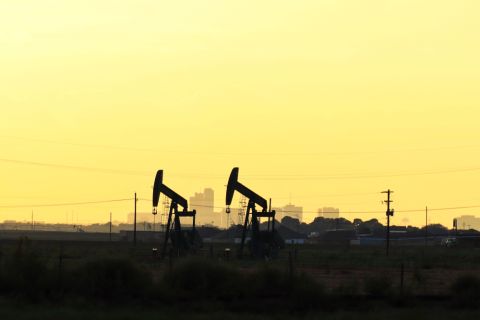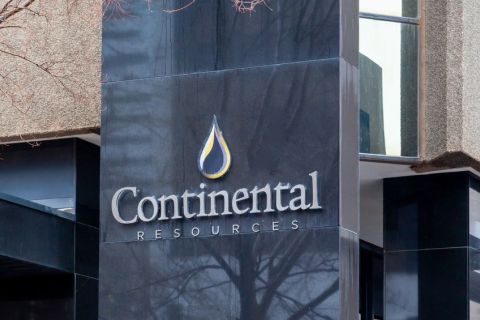
Oil and Gas Investor Editor-in-Chief Steve Toon leads a roundtable at the A&D Strategies and Opportunities conference in Dallas featuring Craig Lande of RBC Richardson Barr, Jay Salitza of KeyBanc Capital, Jacob Nagy of Petrie Partners, and Derek Detring of Detring Energy Advisors. (Source: Hart Energy)
DALLAS—A resurgence in upstream A&D activity ultimately depends on when public equity markets quit punishing operators for not yet having shown them the money, according to asset and corporate marketers.
“The equity markets have to open and they will,” Craig Lande, a managing director with RBC Richardson Barr, said at Oil and Gas Investor’s recently held A&D Strategies and Opportunities conference.
“If talking to any public company CEO, they’re only happy when they’re buying. They’re not happy [just with] executing. They’ll be back. You just have to hold your nose until it gets there.”
Meanwhile, deals that are getting done are taking longer, said Jay Salitza, a managing director for KeyBanc Capital Markets Inc. Non-marketed transactions already take longer to close than marketed transactions, but “one I’ve been working on has been going on for nine months now,” Lande said.
“We’ve seen a big pickup in activity. Lots going on.”
But they’re taking longer to close, he said.
Jacob Nagy, a partner with Petrie Partners, noted that transaction activity in the Permian Basin stopped in mid-2017 until a few deals this year: Diamondback Energy Inc.’s (NASDAQ: FANG) purchase of Energen Corp. (NYSE: EGN) and Ajax Resource LLC, and Concho Resources Inc.’s acquisition of RSP Permian Inc.
“Talk about this slowness in A&D is really all Permian-related…,” he said. “And that’s trickling into the sentiment of the broader market.”
Derek Detring, president of Detring Energy Advisors, said that, if deducting the Diamondback and Concho deals from the 2018 volume as well as excluding the BP Plc (NYSE: BP) deal for BHP Billiton Ltd.’s (NYSE: BHP) property in the Haynesville, Eagle Ford and Permian, “we’re down to about $10 billion a quarter of activity.”
That’s the 2015 activity level, he said, “which is kind of scary because usually, a 30% and 40% increase in oil price lubricates the A&D market.”
“We’ve had this disconnect the past three or four quarters as Wall Street is telling the bigger guys that are public to rein in their spending—‘live within free cash flow’—and it’s been interesting to watch this trickle all the way down [in the transaction market].”
Factors affecting dealmaking, Salitza said, “probably depend on the hydrocarbon you’re talking about and the basin you’re in.” He was working at the time on several natural gas-heavy transactions. “Natural gas has always been behind oil in the minds of investors. Having a backwardated curve is definitely not helpful to how valuations get decided between the buyer and the seller.”
Meanwhile, a lot of the prospective buyers’ capital-backers “are somewhat bullish on gas,” he said. “They like the idea of being able to invest a dollar at a multiple of four times and having that create returns as opposed to putting a dollar in oil at eight times and trying to create returns from that.”
Yet, a lot of prospective sellers “don’t have to sell,” he added. Sellers may be high-grading the portfolio “or whatever buzzword you want to use,” but “they’re not in any distress to need to sell.”
Merit Energy Co. is buying the Fayetteville portion of the BHP Billiton package. Privately-held Flywheel Energy LLC, backed by Kayne Private Energy Income Funds, is buying Southwestern Energy Co.’s (NYSE: SWN) Fayetteville unit.
“Fayetteville was the place to be 10 years ago or more,” Salitza said, “and now it’s more of a yield-friendly asset and that’s (yield-seeking buyers are who) we’re seeing snatch that up.”
PDP properties are key in transactions now, Lande said, which is prompting private-equity startups that were buying and flipping just acreage the past few years to start drilling.
“No one really wants to buy just acreage right now...,” Lande said. “You need PDP for, basically, anyone to underwrite these deals.”
Leading PDP buyers had been the MLPs before 2015. “And, God, we [asset marketers as well as sellers] miss the MLPs, but … you still have the Merits of the world,” he said.
“Those guys have much more longer-dated private equity funds of 10 and 12 and 15 years…. They’ve been waiting for the MLPs to die. Now is their time.”
Recommended Reading
As ONEOK Digests Magellan, Sets Stage for More NGL Growth in 2024
2024-02-28 - ONEOK is continuing the integration of its newly acquired Magellan assets in 2024 as the company keeps an eye out for M&A opportunities and awaits regulatory approvals for certain projects.
Dallas Fed Energy Survey: Permian Basin Breakeven Costs Moving Up
2024-03-28 - Breakeven costs in America’s hottest oil play continue to rise, but crude producers are still making money, according to the first-quarter Dallas Fed Energy Survey. The situation is more dire for natural gas producers.
Enterprise Buys Assets from Occidental’s Western Midstream
2024-02-22 - Enterprise bought Western’s 20% interest in Whitethorn and Western’s 25% interest in two NGL fractionators located in Mont Belvieu, Texas.
EIA: E&P Dealmaking Activity Soars to $234 Billion in ‘23
2024-03-19 - Oil and gas E&Ps spent a collective $234 billion on corporate M&A and asset acquisitions in 2023, the most in more than a decade, the U.S. Energy Information Administration reported.
Continental Resources Makes $1B in M&A Moves—But Where?
2024-02-26 - Continental Resources added acreage in Oklahoma’s Anadarko Basin, but precisely where else it bought and sold is a little more complicated.






